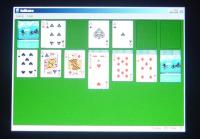Hitachi CML174 17'' LCD Plus Samsung 172T Revisted
by Kristopher Kubicki on February 12, 2003 3:24 AM EST- Posted in
- Displays
Gaming on the CML174 – Response Time
Without sensitive light meters we are somewhat resorted to the unfortunate analysis of just looking at the image while playing some high intensity games. We say unfortunate because this benchmark becomes more psychological than metrological. Simply knowing that the CML174 does or does not have a quick response time would skew a visual examination of the unit. That being said, we are still going to take a look at a few games and give our impression between the Samsung 172T and the Hitachi CML174.
Max Payne
The contrasting light and dark images in Max Payne make it great for testing LCD's on. If anyone has turned the brightness way up on the black maze levels they will know it becomes real easy to tell where to walk. On the CML174, even after adjusting our monitor brightness to the sweet spot described in the benchmark, we could too easily distinguish platform from pitfall during the black mazes. The Samsung 172T provided a much larger challenge, although still not perfect. Other mentionable observations include intense streaking on the analog connections for both of these monitors. DVI looked great on both; no streaking, no ghosting.

Digital photo, not screen shot
MechWarrior 4 Mercenaries
Slightly faster paced than Max Payne, MW4M demonstrates a lot of fast, light on dark motion. The 172T demonstrated its inability to keep up with 90fps rockets fairly early in the game. The 172T did alright on the Max Payne test, but some of the arena battles in MW4M began to stress our patience. Objects that tended to change direction rapidly such as fragments bouncing off a wall were the most disorienting. Objects like lasers that do not change direction where not nearly as detectable. That being said, the CML174 showed the most of its domination right here. We still noticed a small amount of blur when analyzing the screen very closely, but we came to the consensus that the CML174 demonstrated a much better fast motion experience.
UT2003
Combining fast motion and color rendition, UT2003 lays somewhere in between Max Payne and MW4W. The color handicap on the CML174 became strikingly apparent on some of the greener arenas where we continually had the feeling that everything had a bluish hint to it. Even though it did not affect game play, we had the impression that we were not seeing the original screen as the creators wanted us to see it. The 172T performed great, but we again noticed some problems with objects changing directions rapidly. Turning rapidly back and forth puts a soft blur around most edges.
Solitaire
Looks good.
DVD playback
We saw surprisingly little difference from one monitor to the other. As expected, our DVD of Men in Black II looked pretty much the same on both screens, while The Matrix demonstrated a very small difference in high motion. DVD (and most other video sources) display video at approximately 30 frames per second or less. Thus, the screen displays each frame for approximately 33ms. Even with a poor response time of 15ms rising and 15ms falling we should notice very little motion blur. The CML174 came close, but could not produce the same rich colors from the 172T.
Even though we could not scientifically test the response times with any accuracy, we noted that the CML174 appeared sharper during high intensity motion. This makes sense because the lower response time assures leading and trailing edges of an object manifest themselves faster. We were a little surprised that DVD playback did not seem to be as dependant on response time as gaming, but after inspecting the logic we concluded that this should have been expected.












0 Comments
View All Comments